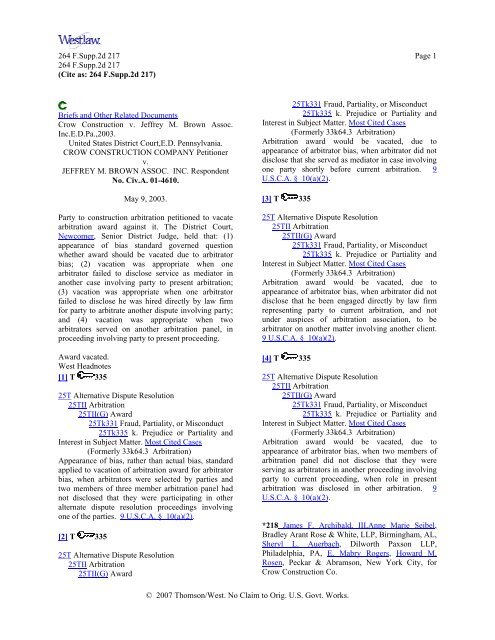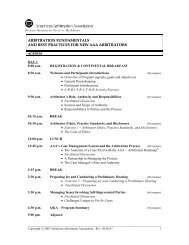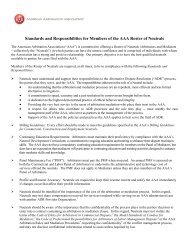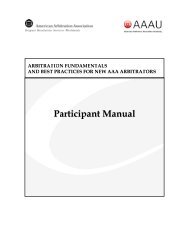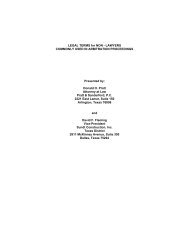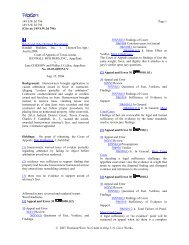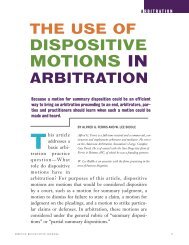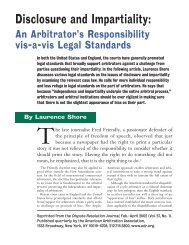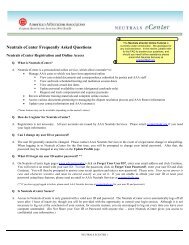Crow Construction Company v. Jeffrey M. Brown Assoc., Inc.
Crow Construction Company v. Jeffrey M. Brown Assoc., Inc.
Crow Construction Company v. Jeffrey M. Brown Assoc., Inc.
Create successful ePaper yourself
Turn your PDF publications into a flip-book with our unique Google optimized e-Paper software.
264 F.Supp.2d 217 Page 1<br />
264 F.Supp.2d 217<br />
(Cite as: 264 F.Supp.2d 217)<br />
Briefs and Other Related Documents<br />
<strong>Crow</strong> <strong>Construction</strong> v. <strong>Jeffrey</strong> M. <strong>Brown</strong> <strong>Assoc</strong>.<br />
<strong>Inc</strong>.E.D.Pa.,2003.<br />
United States District Court,E.D. Pennsylvania.<br />
CROW CONSTRUCTION COMPANY Petitioner<br />
v.<br />
JEFFREY M. BROWN ASSOC. INC. Respondent<br />
No. Civ.A. 01-4610.<br />
May 9, 2003.<br />
Party to construction arbitration petitioned to vacate<br />
arbitration award against it. The District Court,<br />
Newcomer, Senior District Judge, held that: (1)<br />
appearance of bias standard governed question<br />
whether award should be vacated due to arbitrator<br />
bias; (2) vacation was appropriate when one<br />
arbitrator failed to disclose service as mediator in<br />
another case involving party to present arbitration;<br />
(3) vacation was appropriate when one arbitrator<br />
failed to disclose he was hired directly by law firm<br />
for party to arbitrate another dispute involving party;<br />
and (4) vacation was appropriate when two<br />
arbitrators served on another arbitration panel, in<br />
proceeding involving party to present proceeding.<br />
Award vacated.<br />
West Headnotes<br />
[1] T 335<br />
25T Alternative Dispute Resolution<br />
25TII Arbitration<br />
25TII(G) Award<br />
25Tk331 Fraud, Partiality, or Misconduct<br />
25Tk335 k. Prejudice or Partiality and<br />
Interest in Subject Matter. Most Cited Cases<br />
(Formerly 33k64.3 Arbitration)<br />
Appearance of bias, rather than actual bias, standard<br />
applied to vacation of arbitration award for arbitrator<br />
bias, when arbitrators were selected by parties and<br />
two members of three member arbitration panel had<br />
not disclosed that they were participating in other<br />
alternate dispute resolution proceedings involving<br />
one of the parties. 9 U.S.C.A. § 10(a)(2).<br />
[2] T 335<br />
25T Alternative Dispute Resolution<br />
25TII Arbitration<br />
25TII(G) Award<br />
25Tk331 Fraud, Partiality, or Misconduct<br />
25Tk335 k. Prejudice or Partiality and<br />
Interest in Subject Matter. Most Cited Cases<br />
(Formerly 33k64.3 Arbitration)<br />
Arbitration award would be vacated, due to<br />
appearance of arbitrator bias, when arbitrator did not<br />
disclose that she served as mediator in case involving<br />
one party shortly before current arbitration. 9<br />
U.S.C.A. § 10(a)(2).<br />
[3] T 335<br />
25T Alternative Dispute Resolution<br />
25TII Arbitration<br />
25TII(G) Award<br />
25Tk331 Fraud, Partiality, or Misconduct<br />
25Tk335 k. Prejudice or Partiality and<br />
Interest in Subject Matter. Most Cited Cases<br />
(Formerly 33k64.3 Arbitration)<br />
Arbitration award would be vacated, due to<br />
appearance of arbitrator bias, when arbitrator did not<br />
disclose that he been engaged directly by law firm<br />
representing party to current arbitration, and not<br />
under auspices of arbitration association, to be<br />
arbitrator on another matter involving another client.<br />
9 U.S.C.A. § 10(a)(2).<br />
[4] T 335<br />
25T Alternative Dispute Resolution<br />
25TII Arbitration<br />
25TII(G) Award<br />
25Tk331 Fraud, Partiality, or Misconduct<br />
25Tk335 k. Prejudice or Partiality and<br />
Interest in Subject Matter. Most Cited Cases<br />
(Formerly 33k64.3 Arbitration)<br />
Arbitration award would be vacated, due to<br />
appearance of arbitrator bias, when two members of<br />
arbitration panel did not disclose that they were<br />
serving as arbitrators in another proceeding involving<br />
party to current proceeding, when role in present<br />
arbitration was disclosed in other arbitration. 9<br />
U.S.C.A. § 10(a)(2).<br />
*218 James F. Archibald, III,Anne Marie Seibel,<br />
Bradley Arant Rose & White, LLP, Birmingham, AL,<br />
Sheryl L. Auerbach, Dilworth Paxson LLP,<br />
Philadelphia, PA, E. Mabry Rogers, Howard M.<br />
Rosen, Peckar & Abramson, New York City, for<br />
<strong>Crow</strong> <strong>Construction</strong> Co.<br />
© 2007 Thomson/West. No Claim to Orig. U.S. Govt. Works.
264 F.Supp.2d 217 Page 2<br />
264 F.Supp.2d 217<br />
(Cite as: 264 F.Supp.2d 217)<br />
Steven Barshov, Stadtmauer Bailkin, LLP, New York<br />
City, Roy S. Cohen, Edward T. DeLisle, Nicole L.<br />
Herman, Cohen Seglias Pallas & Greenhall,<br />
Philadelphia, PA, for <strong>Jeffrey</strong> M. <strong>Brown</strong> <strong>Assoc</strong>iates,<br />
<strong>Inc</strong>.<br />
Bruce L. Phillips, Venzie, Phillips & Warshawer,<br />
Philadelphia, PA, for George C. Wood.<br />
OPINION<br />
NEWCOMER, Senior District Judge.<br />
Presently before the Court is Petitioner <strong>Crow</strong><br />
<strong>Construction</strong> <strong>Company</strong>'s Petition to Vacate an<br />
Arbitration Award, Respondent, <strong>Jeffrey</strong> M. <strong>Brown</strong><br />
<strong>Assoc</strong>iate <strong>Inc</strong>.'s Response, as well as the parties'<br />
various supplemental briefs.<br />
BACKGROUND<br />
On August 17, 1994, Petitioner, <strong>Crow</strong> <strong>Construction</strong><br />
<strong>Company</strong> (“<strong>Crow</strong>”) was hired by the Respondent,<br />
general contractor <strong>Jeffrey</strong> M. <strong>Brown</strong> <strong>Assoc</strong>iates, <strong>Inc</strong>.<br />
(“JMB”), to assist in completing a construction<br />
project located in Brooklyn, New York. When<br />
disputes arose between the two in 1995, pursuant to<br />
the parties' contractual agreement, JMB filed a<br />
Demand for Arbitration against <strong>Crow</strong> in Philadelphia<br />
seeking $1,319,880 in damages. <strong>Crow</strong> asserted a<br />
counterclaim for $1,883,074.<br />
After settlement efforts proved unsuccessful, the<br />
arbitration became active in 1997. The American<br />
Arbitration <strong>Assoc</strong>iation (“AAA”) three-arbitrator<br />
tribunal was seated after the parties had completed<br />
the arbitrator selection process. During this selection<br />
process the parties were given a *219 list of eligible<br />
arbitrators and were asked to rank the arbitrators<br />
proposed by the AAA in their order of preference.<br />
The AAA utilized those rankings in selecting the<br />
arbitrators ultimately seated on the panel. The three<br />
arbitrators chosen were Judith P. Meyer, Esquire,<br />
Peter A. Galante, Esquire, and William Argeros, III.<br />
FN1 A Preliminary Hearing was held on November 3,<br />
1997, and the hearings officially began in January of<br />
1998. On November 16, 2000, during a short break<br />
from that day's hearings, <strong>Crow</strong>'s lead attorney,<br />
Howard Rosen, overheard Arbitrators Meyer and<br />
Galante discussing the scheduling of another<br />
arbitration with JMB's lead attorney, Roy Cohen. It<br />
was at this time that the arbitrators disclosed to <strong>Crow</strong>,<br />
for the first time, that they had been selected to<br />
arbitrate another case in which JMB was a party, the<br />
JMB/Greenfield matter.<br />
FN1. Mr. Argeros was appointed prior to the<br />
start of the arbitration proceedings in the<br />
place of Joseph A. Torregrossa, Esquire who<br />
resigned from the Panel early in the<br />
proceedings.<br />
<strong>Crow</strong> immediately objected to the arbitrators' failure<br />
to disclose their other case involving Cohen and<br />
JMB. On November 20, 2000, pursuant to <strong>Crow</strong>'s<br />
objections, the AAA sent a letter to <strong>Crow</strong> confirming<br />
that arbitrators Meyer and Galante were serving as<br />
arbitrators in another case involving JMB. In<br />
addition, the AAA disclosed for the first time that<br />
Cohen or his firm, Cohen, Seglias, Pallas & Furman,<br />
P.C. (Cohen Seglias), had selected Ms. Meyer<br />
through the AAA to mediate two cases involving one<br />
of Cohen Seglias' other clients. <strong>Crow</strong> subsequently<br />
requested further information from the AAA<br />
regarding these disclosures. Ms. Meyer then<br />
amended her disclosure to indicate that she was<br />
engaged by Cohen Seglias in two additional<br />
mediations (a total of four), one of which involved<br />
JMB, at the same time the arbitration hearings<br />
between JMB and <strong>Crow</strong> were taking place. Based<br />
on this new information, on November 30, 2000, and<br />
again on December 7, 2000, <strong>Crow</strong> formally objected<br />
to arbitrators Galante and Meyer's involvement in the<br />
JMB/<strong>Crow</strong> arbitration.<br />
On April 13, 2001, the arbitrators published their<br />
findings in which they awarded JMB every dollar<br />
sought, exclusive of attorneys' fees and damages in a<br />
late claim JMB brought against <strong>Crow</strong> in the closing<br />
days of the arbitration. On September 10, 2001, this<br />
Court received <strong>Crow</strong>'s Motion to Vacate the<br />
Arbitration Award which was originally filed in the<br />
Southern District of New York. This Court afforded<br />
the parties an opportunity to take discovery. In its<br />
post-discovery brief, <strong>Crow</strong> reported uncovering<br />
multiple instances before, during and after the<br />
JMB/<strong>Crow</strong> arbitration in which arbitrators Galante<br />
and Meyer served on an arbitration panel where<br />
Cohen Seglias represented one of the parties. Some<br />
of the information uncovered during the discovery<br />
period concerning arbitrators Galante and Meyer had<br />
never been disclosed previously.<br />
In an attempt to clarify the facts of the case and the<br />
claims at issue, this Court held an evidentiary<br />
hearing. In order to clarify and address Petitioner's<br />
claims, the following summarizes the relevant facts<br />
which serve as the basis for Petitioner's Motion to<br />
Vacate. Both arbitrators Meyer and Galante served<br />
as arbitrators in the JMB/Greenfield matter while at<br />
the same time as serving as arbitrators in the<br />
© 2007 Thomson/West. No Claim to Orig. U.S. Govt. Works.
264 F.Supp.2d 217 Page 3<br />
264 F.Supp.2d 217<br />
(Cite as: 264 F.Supp.2d 217)<br />
JMB/<strong>Crow</strong> matter. The Respondent points out that<br />
the JMB/<strong>Crow</strong> matter was nearly complete when the<br />
JMB/Greenfield matter commenced. At the same<br />
time or before the JMB/<strong>Crow</strong> matter started Mr.<br />
Galante served as an arbitrator and/or mediator,<br />
under AAA auspices, in eight additional matters in<br />
which Cohen Seglias represented one of the parties<br />
involved. Notably, in *220 one of these matters, Mr.<br />
Galante was hired and paid directly by Cohen Seglias<br />
(not under AAA auspices) to serve as an arbitrator.<br />
Mr. Galante did not testify at this Court's hearing.<br />
Ms. Meyer testified before this Court to serving as a<br />
mediator in four matters in which Cohen Seglias<br />
represented one of the parties involved. In addition,<br />
in 1997, Ms. Meyer was selected to mediate a case<br />
involving JMB. Ms. Meyer's involvement in this case<br />
was limited to approximately two hours of<br />
preliminary review. During the hearing in this<br />
matter Ms. Meyer testified to spending that time<br />
reviewing preliminary information contained in the<br />
case file. None of the involvement in the arbitrations<br />
or mediations discussed above were disclosed to<br />
<strong>Crow</strong> during the arbitrator selection process in the<br />
JMB/<strong>Crow</strong> arbitration or anytime thereafter.<br />
However, arbitrators Galante and Meyer's<br />
involvement in the JMB/<strong>Crow</strong> arbitration was<br />
disclosed to the parties in the JMB/Greenfield<br />
arbitration.<br />
DISCUSSION<br />
I. Legal Standard<br />
[1] Congress vested the federal courts with power to<br />
vacate an arbitration award “[w]here there was<br />
evident partiality...in the arbitrators....” 9 U.S.C.A. §<br />
10(a)(2). While this statutory provision appears to<br />
be straightforward in both meaning and application,<br />
the parties here have proven otherwise. In support of<br />
their positions, the parties rely on seemingly<br />
contradictory interpretations of Congress' intent<br />
behind the use of the term “evident partiality” in<br />
setting the vacatur standard. The Petitioner relies on<br />
a United States Supreme Court holding that “evident<br />
partiality” is established when arbitrators fail to<br />
disclose “any dealings that might create an<br />
impression of possible bias.” Commonwealth<br />
Coatings Corp. v. Continental Casualty Co., 393 U.S.<br />
145, 149, 89 S.Ct. 337, 21 L.Ed.2d 301 (1968). On<br />
the other hand, the Respondent relies on Third Circuit<br />
caselaw holding that evident partiality is present only<br />
when “ ‘a reasonable person would have to conclude<br />
that the arbitrator was partial’ to the other party to the<br />
arbitration.” Kaplan v. First Options of Chicago,<br />
<strong>Inc</strong>., 19 F.3d 1503, 1523 n. 30 (3d Cir.1994) (quoting<br />
Apperson v. Fleet Carrier Corp., 879 F.2d 1344,<br />
1358 (6th Cir.1989)). The use of these seemingly<br />
contradictory interpretations illustrates what appears<br />
to be a fundamental misunderstanding concerning the<br />
complicated caselaw in this area. The following<br />
analysis sifts through this enigmatic area of law in an<br />
attempt to clarify these legal principles and determine<br />
which of these standards is appropriate for<br />
application here.<br />
A close examination of this area of law reveals two<br />
separate standards meant for application under<br />
significantly different circumstances. In the interest<br />
of simplicity, the Court will refer to these standards<br />
as the “appearance of bias standard” and the “actual<br />
bias standard”. The key to understanding the<br />
important differences between them begins with an<br />
overview of their origins.<br />
A. Appearance of Bias Standard<br />
The appearance of bias standard, the first of the two<br />
standards, was formed in 1968 when the United<br />
States Supreme Court considered Commonwealth<br />
Coatings. The Commonwealth Coatings Court was<br />
presented with a situation whereby a neutral<br />
arbitrator, that is, an arbitrator chosen not unilaterally<br />
by the plaintiff, defendant or by an outside party but<br />
rather directly or indirectly by both parties, held<br />
undisclosed business ties with one of the parties<br />
involved in the arbitration. Commonwealth Coatings,<br />
393 U.S. at 147, 89 S.Ct. 337. In what has been<br />
erroneously referred to as a plurality opinion, the<br />
*221 Court vacated the arbitration award based on<br />
the neutral arbitrator's failure to “disclose to the<br />
parties any dealings that might create an impression<br />
of possible bias.” Id. The result is the appearance of<br />
bias standard which holds that evident partiality is<br />
established when arbitrators fail to disclose any<br />
relationships that might create an impression of<br />
possible bias.<br />
B. Actual Bias Standard<br />
The Respondent argues strongly in favor of applying<br />
an actual bias standard. In doing so, the Respondent<br />
relies almost exclusively on Kaplan's footnote 30<br />
where the Third Circuit borrows Sixth Circuit<br />
language to indicate that evident partiality is only<br />
present “when a reasonable person would have to<br />
conclude that an arbitrator was partial” to one of the<br />
© 2007 Thomson/West. No Claim to Orig. U.S. Govt. Works.
264 F.Supp.2d 217 Page 4<br />
264 F.Supp.2d 217<br />
(Cite as: 264 F.Supp.2d 217)<br />
parties. Kaplan, 19 F.3d at 1523, n. 30 (3d Cir.1994).<br />
In Kaplan, the Third Circuit's cursory mention of the<br />
evident partiality standard consists largely of a single<br />
sentence taken from the Sixth Circuit's Apperson v.<br />
Fleet Carrier Corp. The Sixth Circuit's approach in<br />
Apperson is directly taken from the Second Circuit's<br />
Morelite <strong>Construction</strong> Corp. v. New York City<br />
District Council Carpenters Benefit Funds, 748 F.2d<br />
79 (2d. Cir.1984). Thus, the origins of the actual<br />
bias standard can be traced directly to the Second<br />
Circuit's break from the Commonwealth Coatings<br />
holding in Morelite.<br />
C. Which Standard Should be Applied Here?<br />
With a brief introduction to the two standards out of<br />
the way, the Court now turns its attention to the vital<br />
issue at hand, that is, which of the two standards<br />
should be applied here? For the reasons that follow,<br />
this Court finds that application of the appearance of<br />
bias standard is appropriate in this case.<br />
1. Problems with Morelite<br />
The Morelite Court was able to sidestep the<br />
Commonwealth Coatings holding and appearance of<br />
bias standard by declaring Commonwealth Coatings<br />
to be nothing more than a plurality opinion<br />
accompanied by an irreconcilable concurring<br />
opinion. Morelite, 748 F.2d at 83. This Court<br />
respectfully disagrees with the Second Circuit's<br />
approach for the following four reasons.<br />
First, “Commonwealth Coatings is not a plurality<br />
opinion.” Schmitz v. Zilveti, 20 F.3d 1043, 1045 (9th<br />
Cir.1994). Even though Justice White wrote a<br />
concurring opinion, he clearly indicated that “he<br />
joined in the ‘majority opinion’ but wrote to make<br />
‘additional remarks'.” Id. Justice White's use of the<br />
term “majority opinion” speaks for itself. Without<br />
his vote, the opinion could have never been referred<br />
to as a majority opinion. In addition, with Justice<br />
White's vote, Justice Black's opinion had the five<br />
votes necessary to gain the moniker “opinion of the<br />
Court,” which is clearly used by the Court in<br />
introducing the decision. Commonwealth Coatings,<br />
393 U.S. at 145, 89 S.Ct. 337.<br />
Second, Justice White's concurring opinion is not<br />
irreconcilable with the Court's opinion as it does<br />
nothing to contradict the majority's stance. It is<br />
significant that in his concurrence, Justice White<br />
never even mentions the words “appearance of bias”<br />
or suggests in any way that the appearance of bias<br />
standard is inappropriate. Instead, in what the<br />
Morelite Court cites as language contradicting the<br />
Court's opinion, Justice White obviously accepts the<br />
Court's decision and the appearance of bias standard<br />
by issuing the following clarification, “arbitrators are<br />
not automatically disqualified by a business<br />
relationship with the parties before them if both<br />
parties are informed of the relationship in advance, or<br />
*222 if they are unaware of the facts but the<br />
relationship is trivial.” Commonwealth Coatings,<br />
393 U.S. at 151, 89 S.Ct. 337 (White, J., concurring).<br />
Rather than rejecting the appearance of bias standard<br />
Justice White clearly embraces it and attempts to<br />
refine it by more accurately defining its parameters.<br />
In addition, it should be noted that Justice White's<br />
narrowly tailored adjustment leaves the appearance<br />
of bias standard, as a whole, untouched.<br />
Third, not only does Justice White's concurring<br />
opinion fail to contradict the Court's opinion, it<br />
actually complements it. The premise of the Court's<br />
opinion is that arbitrators shall “disclose to the parties<br />
any dealings that might create an impression of<br />
possible bias.” Id. at 149, 89 S.Ct. 337. Likewise, a<br />
great deal of Justice White's concurring opinion is<br />
dedicated to encouraging what he calls “frankness at<br />
the outset,” or disclosure. Id. at 151, 89 S.Ct. 337.<br />
In this regard, both opinions share the same goal,<br />
disclosure. The two opinions work in unison to<br />
suggest that the arbitration process is most effective<br />
and less prone to judicial intervention when<br />
disclosure is made properly at the outset. If<br />
anything, Justice White's opinion strengthens the<br />
Court's opinion in this regard.<br />
Fourth, and perhaps most notable, Justice White went<br />
to the trouble of drafting a concurring opinion.<br />
Presumably, if this was done with the intent to<br />
debunk the appearance of bias standard, Justice<br />
White would have expressly done so. Instead, as<br />
explained above, Justice White chose not only to<br />
embrace appearance of bias standard, but also chose<br />
to omit any mention of another possible standard,<br />
such as Morelite's actual bias standard or another<br />
similar standard.<br />
2. Morelite and its progeny are inapplicable here<br />
Even if this Court is mistaken in finding that<br />
Morelite's assessment of Commonwealth Coatings is<br />
in error, Morelite and its progeny do not apply here.<br />
In the wake of the Morelite Opinion a growing<br />
number of courts, including this one, have embraced<br />
© 2007 Thomson/West. No Claim to Orig. U.S. Govt. Works.
264 F.Supp.2d 217 Page 5<br />
264 F.Supp.2d 217<br />
(Cite as: 264 F.Supp.2d 217)<br />
the notion that Morelite's actual bias standard does<br />
not apply to all arbitration cases where evident<br />
partiality is alleged. Contained in the following<br />
analysis of Morelite, its progeny and the development<br />
of the actual bias standard is a crucial point which<br />
has gone unaddressed by the parties here as well as<br />
some other courts in similar cases. Regardless of<br />
whether a court considers the actual bias standard to<br />
be legitimate (this Court does not), such a standard<br />
does not apply in cases, such as this one, where (1)<br />
the parties have some influence in selecting their<br />
arbitrators and (2) an arbitrator failed to disclose<br />
information which may create a reasonable<br />
impression of the arbitrator's partiality. In situations<br />
where these two factors are present this Court, the<br />
Ninth Circuit and the Supreme Court of Texas have<br />
found that the Commonwealth Coatings appearance<br />
of bias standard should be applied. Forest Electric<br />
Corporation v. HCB Contractors, 1995 WL 37586,<br />
*3 (E.D.Pa.1995) (Padova, J.); Schmitz, 20 F.3d at<br />
1047; Burlington Northern Railroad Co. v. TUCO,<br />
<strong>Inc</strong>. 960 S.W.2d 629, 636 (Tex.1997). The grounds<br />
for such a finding are largely based on the reasoning<br />
of the Commonwealth Coatings Court. As discussed<br />
earlier, both Justice White's concurring opinion and<br />
the Court's opinion place a premium on disclosure<br />
and its importance in the arbitrator selection process.<br />
These opinions suggest that the parties are the best<br />
judge of bias and in order to be able to choose<br />
intelligently they must be made aware of all the facts<br />
showing potential partiality. *223Commonwealth<br />
Coatings, 393 U.S. at 148, 89 S.Ct. 337; Id. at 151,<br />
89 S.Ct. 337. Thus, when an arbitrator is selected by<br />
the parties after having failed to disclose a fact which<br />
may create the appearance of bias, the selection<br />
process is prone to failure.<br />
The Morelite actual bias standard was conceived in a<br />
case where the parties had no influence during the<br />
arbitrator selection process. (In Morelite, “[the]<br />
collective bargaining agreement provided for<br />
designation of a single neutral arbitrator without<br />
participation of the parties.” Burlington, 960 S.W.2d<br />
at 636.) Moreover, the facts giving rise to the<br />
alleged impropriety in Morelite were fully disclosed<br />
to all parties involved at the outset of the arbitration.<br />
Morelite 748 F.2d at 81. Disclosure was never an<br />
issue.<br />
Likewise, the Sixth Circuit faced a similar scenario in<br />
Apperson when it chose to adopt the Morelite actual<br />
bias standard. In Apperson, just as in Morelite, a<br />
collective bargaining agreement provided for<br />
preselected “arbitration committees” on the local,<br />
regional and national levels which excluded the<br />
parties from playing any role in selecting their<br />
arbitrators. Apperson, 879 F.2d at 1347. In<br />
addition, the Apperson Court indicated that its<br />
decision not to consider the bias claim was partially<br />
based on the premise that the facts giving rise to the<br />
allegation of bias were known to the challenging<br />
party at the arbitration's outset. Id. at 1359-60.<br />
Finally, in Kaplan, the Third Circuit faced a similar<br />
scenario. Although the Court does not describe what<br />
the exact arbitration selection process was, it does<br />
indicate that the arbitration at issue was conducted<br />
under the rules of the Philadelphia Stock Exchange.<br />
Kaplan, 19 F.3d at 1505. This Court's research<br />
failed to unearth what those rules were at the time in<br />
question. Presumably, the rules of the Exchange at<br />
that time, like the other corporate arbitration<br />
agreements considered here, offered the parties little<br />
or no input into the arbitrator selection process.<br />
Regardless, the significant point in our consideration<br />
of Kaplan is that the challenging party never alleged<br />
a failed disclosure as the basis for a finding of<br />
evident partiality. Instead, the Kaplans based their<br />
showing of evident partiality on the performance of<br />
the arbitrators during the arbitration process.<br />
Specifically, they allege “through a long series of<br />
irrational and unfair rulings, throughout the course of<br />
the [arbitration] proceedings, the arbitrators<br />
consistently (and without basis) disfavored the<br />
Kaplans and favored First Options.” Appellant's<br />
Brief p. 33.<br />
Morelite, Apperson and Kaplan all have a common<br />
theme which distinguishes them from the case at<br />
hand as well as application of the actual bias<br />
standard. As we have seen in each of these cases,<br />
with the possible exception of Kaplan, the parties had<br />
no influence in the selection of their presiding<br />
arbitrators. More importantly, none of these cases<br />
involved a failed disclosure on behalf of an arbitrator.<br />
Thus, the arbitration process as opposed to the<br />
arbitrator selection process is at issue in these cases.<br />
The contrary is the case in the matter presently before<br />
the Court. Here, by submitting their preferences in<br />
arbitrators, the parties were provided with some<br />
influence in the arbitrator selection process. In<br />
addition, the Petitioner alleges a failed disclosure on<br />
behalf of two of the three arbitrators involved. The<br />
Petitioner is challenging the arbitrator selection<br />
process as opposed to the arbitration process itself.<br />
As explained in the preceding, these significant<br />
differences with Morelite and its progeny suggest that<br />
even if this Court's consideration of Morelite is in<br />
error the actual bias standard is inapplicable and that<br />
the Commonwealth Coatings appearance*224 of bias<br />
© 2007 Thomson/West. No Claim to Orig. U.S. Govt. Works.
264 F.Supp.2d 217 Page 6<br />
264 F.Supp.2d 217<br />
(Cite as: 264 F.Supp.2d 217)<br />
standard is the appropriate standard to apply here.<br />
III. Application of the Appearance of Bias<br />
Standard<br />
With the appropriate standard determined, the Court<br />
turns its attention to application of the appearance of<br />
bias standard. In support of its Petition to Vacate,<br />
the Petitioner raises a number of allegations<br />
concerning arbitrators Galante and Meyer's failure to<br />
disclose relationships. Petitioner argues that these<br />
failed disclosures amount to evident partiality.<br />
This Court is unpersuaded by Petitioner's allegations<br />
in so far as they concern Mr. Cohen's or Cohen<br />
Seglias' representation of a party appearing before<br />
either arbitrator Galante or Meyer in a AAA<br />
sponsored arbitration or mediation before, during or<br />
after the JMB/<strong>Crow</strong> arbitration. These so called<br />
relationships appear to be exactly what Justice White<br />
was alluding to in his concurring opinion in<br />
Commonwealth Coatings when he cautioned against<br />
vacating an arbitration award based on undisclosed<br />
trivial business relationships. Commonwealth<br />
Coatings, 393 U.S. at 150, 89 S.Ct. 337 (White, J.,<br />
concurring opinion).<br />
[2] More troubling are Petitioner's remaining<br />
allegations concerning the arbitrators' more extensive<br />
undisclosed ties with JMB and Cohen Seglias.<br />
Specifically, Ms. Meyer's failure to disclose her role<br />
as a mediator in a case involving JMB, Mr. Galante's<br />
failure to disclose his private dealings with Cohen<br />
Seglias as a hired arbitrator in 1999 and both<br />
arbitrators' failure to disclose their roles in the<br />
JMB/Greenfield matter amount to nothing less than<br />
the appearance of bias.<br />
There is no question that under AAA rules the<br />
arbitrators were required to disclose these dealings to<br />
JMB and <strong>Crow</strong>. Cannon II of the AAA's Code of<br />
Ethics for Commercial Arbitrators provides that<br />
arbitrators have a continuing duty during proceedings<br />
to disclose “any past or present relationships with the<br />
parties or their representatives.” A relationship is<br />
defined by the Cannon as “any existing or past<br />
financial, business, professional...relationships which<br />
are likely to affect partiality or which might<br />
reasonably create an appearance of partiality or bias.”<br />
While this provision is not a governing standard here,<br />
it serves as a benchmark to assess the alleged failed<br />
disclosures under the appearance of bias standard and<br />
raises the question of the severity of these infractions.<br />
Ms. Meyer's failure to disclose her prior dealing with<br />
JMB in a mediation which occurred at or about the<br />
same time as the JMB/<strong>Crow</strong> proceeding raises<br />
several concerns. First, since the two proceedings<br />
took place at roughly the same time there is little<br />
doubt that JMB's presence in both matters was not<br />
simply forgotten by Ms. Meyer. Given this fact it<br />
becomes difficult to account for the failure to<br />
disclose without considering the possibility of bias.<br />
FN2 Second, the obvious concern here is that<br />
information gleaned in the two hour review of the<br />
mediation case could prejudice <strong>Crow</strong> in the<br />
JMB/<strong>Crow</strong> arbitration by, among other things, not<br />
giving <strong>Crow</strong> a chance to respond to any information<br />
about JMB learned in the mediation and applied in<br />
the JMB/<strong>Crow</strong> matter. Disclosure is mandated*225<br />
to enable parties to proceedings, such as this one, to<br />
avoid such a scenario. <strong>Crow</strong> should have been<br />
notified of the potential conflict in order to have a<br />
chance to respond accordingly, or, at the very least,<br />
seek an alternate arbitrator. Ms. Meyer's failure to<br />
make the necessary disclosure gives rise to an<br />
obvious appearance of bias.<br />
FN2. This Court notes that its opinion is<br />
based on an appearance of bias and in no<br />
way intends make a determination as to the<br />
partiality of arbitrators Galante and Meyer.<br />
While these arbitrators clearly failed to<br />
adhere to the disclosure rules they are bound<br />
to operate under, there is no evidence or<br />
suggestion that they consciously disregarded<br />
these rules in an attempt to bias the<br />
proceedings.<br />
[3] Mr. Galante's undisclosed work for Cohen Seglias<br />
is equally troublesome. The fact that at the time the<br />
JMB/<strong>Crow</strong> arbitration was proceeding Cohen Seglias<br />
selected Mr. Galante to arbitrate a matter and paid<br />
him, not under the auspices of AAA but rather<br />
directly, raises a number of obvious issues.<br />
Certainly any time money changes hands directly<br />
between an arbitrator and a representative of one of<br />
the parties involved in a pending arbitration before<br />
that arbitrator, disclosure must take place. Mr.<br />
Galante's failure to disclose this untimely transaction<br />
bears the appearance of bias.<br />
[4] Finally, perhaps most disturbing is the arbitrators'<br />
failure to disclose to <strong>Crow</strong> their role in the<br />
JMB/Greenfield arbitration. While the Respondent<br />
points out that the overlap between the two cases was<br />
minimal, this Court must point out that such an<br />
argument does little to explain the problems<br />
© 2007 Thomson/West. No Claim to Orig. U.S. Govt. Works.
264 F.Supp.2d 217 Page 7<br />
264 F.Supp.2d 217<br />
(Cite as: 264 F.Supp.2d 217)<br />
associated with such a situation. As indicated<br />
earlier, the arbitrators' hearing another case involving<br />
JMB could lead to consideration of facts about<br />
Plaintiff JMB which are largely irrelevant to the<br />
JMB/<strong>Crow</strong> matter. More importantly, any facts<br />
taken from the JMB/Greenfield matter either<br />
consciously or sub-consciously would go<br />
unaddressed by <strong>Crow</strong>. Finally, while it is true the<br />
overlap was short in length, it occurred at the<br />
conclusion of the JMB/<strong>Crow</strong> matter, a crucial time in<br />
which the arbitrators were presumably making their<br />
determinations as to liability and damages. These<br />
factors explain the need for full disclosure, however,<br />
they do not explain the basis for this Court's<br />
determination that the appearance of bias standard<br />
has been met. Arbitrators Galante and Meyer's<br />
decision to disclose their dual roles to the parties in<br />
the JMB/Greenfield matter and not those in the<br />
JMB/<strong>Crow</strong> matter had the effect of placing each of<br />
the parties, with the exception of <strong>Crow</strong>, on<br />
notification of their dual roles. In essence, the<br />
arbitrators acknowledged the importance of<br />
disclosure by making a disclosure to the parties in the<br />
JMB/Greenfield matter but failed to notify <strong>Crow</strong>.<br />
When making their disclosures to the<br />
JMB/Greenfield parties they could reasonably<br />
conclude that they had notified all of the parties<br />
involved in the two matters, except <strong>Crow</strong>, of their<br />
dual roles. Arbitrator Meyer explained while<br />
testifying before this Court that she assumed the<br />
AAA disclosed the situation to <strong>Crow</strong>. Such an<br />
explanation raises another important question, why<br />
make the disclosure in JMB/Greenfield if she<br />
assumed the AAA makes such necessary disclosures?<br />
In addition, during her testimony, Ms. Meyer<br />
explained that she did not notify <strong>Crow</strong> of her<br />
presence in both arbitrations because of an<br />
awkwardness associated with making such a<br />
disclosure to a party in <strong>Crow</strong>'s situation. There is<br />
little doubt that this awkwardness stems from the<br />
appearance of bias associated with such a scenario.<br />
This blatant failure to notify <strong>Crow</strong> of the<br />
JMB/Greenfield arbitration meets and exceeds the<br />
appearance of bias standard.<br />
When considered individually, any one of the above<br />
described failed disclosures constitutes an appearance<br />
of bias. Viewed together as a whole, they constitute<br />
not only the appearance of bias but, perhaps, a<br />
suggestion of bias. Regardless, the Petitioner has<br />
met the appearance of bias standard and therefore has<br />
proven under 9 U.S.C. § 10(a) that evident partiality<br />
is *226 present thereby necessitating vacation of the<br />
arbitration award. The repeated failed disclosures in<br />
the arbitration process here resulted in a selection<br />
process whereby the Petitioner was not afforded a<br />
fair opportunity to make informed choices with<br />
regard to the arbitrators proposed by the AAA. Such<br />
a failure lies in direct contradiction with the spirit of<br />
Commonwealth Coatings and intent behind both the<br />
Court's opinion and Justice White's concurrence in<br />
that matter. Finally, such a failure ultimately fails<br />
the arbitration process as a whole.<br />
AN APPROPRIATE ORDER SHALL FOLLOW.<br />
ORDER<br />
AND NOW, this 9th day of May, 2003, for the<br />
reasons set forth in the accompanying Opinion, it is<br />
hereby ORDERED that Petitioner's Petition to Vacate<br />
the Arbitration Award (Document 1) is GRANTED.<br />
The arbitration award is hereby VACATED. The<br />
Clerk shall mark this matter CLOSED for statistical<br />
purposes.<br />
AND IT IS SO ORDERED.<br />
E.D.Pa.,2003.<br />
<strong>Crow</strong> <strong>Construction</strong> v. <strong>Jeffrey</strong> M. <strong>Brown</strong> <strong>Assoc</strong>. <strong>Inc</strong>.<br />
264 F.Supp.2d 217<br />
Briefs and Other Related Documents (Back to top)<br />
• 2:01CV04610 (Docket) (Sep. 10, 2001)<br />
END OF DOCUMENT<br />
© 2007 Thomson/West. No Claim to Orig. U.S. Govt. Works.


